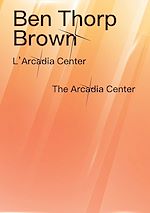
Ben Thorp Brown - L'Arcadia Centrer
Ben Thorp Brown, Laura Herman
Editeur: Jeu de Paume
6,99 €
Intitulée « Le Nouveau Sanctuaire » la douzième édition de la programmation Satellite, confiée à Laura Herman, présente les propositions de Julie Béna, Ben Thorp Brown et Daisuke Kosugi qui étudient, du point de vue de leurs pratiques individuelles, la capacité qu’a l’environnement aménagé d’accueillir le corps et les sens, d’en prendre soin et de les investir.
Comment l’espace détermine-t-il la façon dont nous nous sentons ? Basée sur l’idée d’un environnement menaçant et hostile, l’une des définitions fondamentales de l’architecture est de fournir un abri et un certain confort au corps humain. L’idée répandue de l’habitation comme « peau de substitution » nous vient de l’architecte allemand du XIXe siècle Gottfried Semper qui décrivait l’enclos de l’animal, fait de peaux et de feuillages, comme l’origine de l’espace architectural « privé ».
Aujourd’hui, cette conception de l’architecture comme spatialité enveloppante – le désir moderne d’offrir un lieu de refuge – n’est plus opérante. Si nous devons reconsidérer l’architecture comme le point de rencontre entre différentes références culturelles, différentes pratiques, différents rituels, désirs et besoins, comment imaginer un sanctuaire adapté au monde actuel ?
The 12th Satellite Programme, titled The New Sanctuary and curated by Laura Herman, proposes newly commissioned works by Julie Béna, Ben Thorp Brown and Daisuke Kosugi who, through their individual practices, consider the capacity of the designed environment to host, care and engage with the body and the senses.
How does space determine the way we feel? Predicated on a sense of a threatening and hostile environment, one of the basic definitions of architecture is the provision of shelter and comfort for the human body. The common idea of the dwelling as a “surrogate skin” is derived from the nineteenth-century German architect Gottfried Semper, who described the animal pen, made out of woven skins and leaves, as the origin of the architectural “private” space.
Today, this understanding of architecture as an enveloping spatiality seems no longer to apply. If architecture is to be reconsidered as the meeting point between different cultural references, practices, rituals, desires and needs, how can we imagine a space of sanctuary for today’s world?
Laura Herman